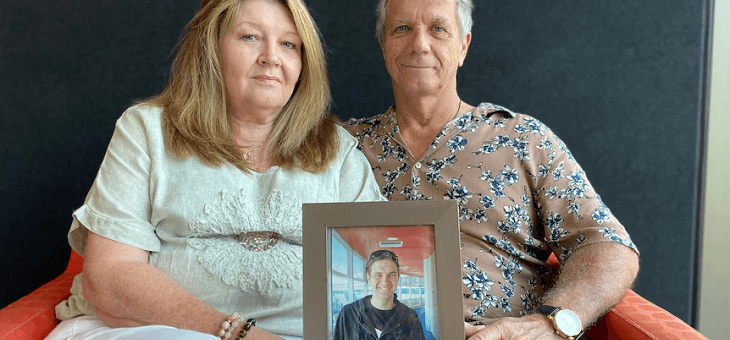When Adam Sager was small he told his mother he was going to break records.
Little did the Sager family know that their son and brother would indeed make history — but in the most heartbreaking way possible.
At 25, just 10 months after being diagnosed with mesothelioma, Adam died.
He became the youngest person to have succumbed to the insidious disease caused by inhaling microscopic asbestos fibres.
Adam’s parents, Julie and Don, believe their eldest child was exposed when he was just 20 months old during a renovation project the couple undertook at their home.
After the 2011 Brisbane floods, Mr and Mrs Sager looked on with horror as thousands of the city’s residents, friends, family members — and of course, the famous Mud Army volunteers — poured into damaged homes, ripping apart fibro walls and ceilings made of asbestos.
Two weeks ago, they witnessed the same scenes as floodwater again inundated south-east Queensland, and also lay waste to thousands of homes across the border in New South Wales.
In an effort to honour their son’s memory and prevent more people from dying from mesothelioma and other asbestos-related illnesses, the Sagers are speaking out about the dangers of asbestos exposure.
‘Fit, healthy’ young man taken too early
The Sagers were young parents in the early 1980s when they decided to “save some money” and paint their new kit home in Townsville.
With the help of some others, the pair sanded the walls and kept their young son confined to the house to prevent him from running out onto the street in the new housing estate where they lived.
“We didn’t realise the walls were asbestos and we had subjected him to asbestos dust as a 20-month-old toddler,” Mrs Sager said.
“We didn’t come from a building family, the house we built was prefabricated, it had no warnings on the outside. We just knew nothing.”
The family moved to Cairns a few years later and Adam grew into a sporty young man who loved martial arts.
He was due to compete in a tournament in Korea when he was diagnosed with mesothelioma.
After battling a persistent cough for weeks, Adam was admitted to hospital one day after collapsing in pain at work.
Doctors drained two litres of fluid from his lungs before conducting dozens of tests, ultimately delivering the terminal cancer diagnosis.
The next 10 months felt like 10 years, said Mrs Sager, “because we spent every waking moment with [Adam]”.
“We moved from Cairns without realising we moved from Cairns, we had support from friends and family so we could just concentrate on him,” she said.
“We just hung out. If we went to the doctor that was just a small part of the day. He had chemo, he did natural therapies.
“We focused on him without making it a big deal.
“To be honest, even the last night we took him to hospital, we still didn’t realise he wasn’t coming home with us.”
Asbestos warnings ‘forgotten’ in rush to help
Fifteen years after they lost Adam and days from what would have been his 40th birthday, Mr and Mrs Sager want to make sure those cleaning up after last month’s floods protect themselves from asbestos exposure.
“We need to get the message out because there were other areas of Brisbane that weren’t affected in 2011 that were impacted by the latest storm event,” Mr Sager said.
“We saw in the newspapers after the 2011 flood reports of asbestos left on footpaths. People had the best intentions but that’s a community health issue.
“That seems to have been forgotten.”
Mrs Sager said it could still be another 10 years before the effects of possible asbestos exposure from 2011 were discovered.
“It could be another 20 years and nothing could happen. That’s the fickle thing about asbestos exposure, it’s non-discriminatory,” she said.
“It doesn’t affect everybody but it may affect somebody.
“There could still be a diagnosis coming another 10 years down the road from the 2011 floods, and now here we go again in 2022. It’s happening again.”
Annual deaths double road toll
Asbestos Disease Support Service general manager Trevor Torrens said each year 4000 people passed away from an asbestos-related disease.
Sometimes, the smallest exposure to the material can cause the worst disease — mesothelioma.
How to safely handle asbestos
Asbestos that is not visibly damaged and painted is safe.
Only when it is broken and becomes airborne does it become dangerous.
Professional asbestos removalists should be employed but in a flood clean-up:
- ensure pieces of fibro are wetted down and bagged
- wear disposable overalls and a mask when dealing with building materials
- don’t leave fibro on a footpath and expose others to the fibres
- know if your house is built before 1990 and take precautions.
(Source: Asbestos Disease Support Service)
Treatments can sometimes extend life expectancy for those with mesothelioma to up to five years, but most die within 12 months of diagnosis.
Mr Torrens said there had been spikes in diagnoses of asbestos-related diseases decades on from major natural disasters such as Cyclone Tracy in Darwin and the 1974 Brisbane floods.
“We’re yet to see people [diagnosed] from the 2011 floods, the Bundaberg flood, recent bushfires,” he said.
“The Queensland spirit in rushing in to help is very commendable but once the fibres become airborne, [they’re dangerous].
“Any house built before 1990 potentially includes asbestos; it could be in the roof, the walls, even the lino.
“We don’t understand why some people get it and some people don’t, but the science shows it takes decades to manifest in disease.
“Mesothelioma, asbestosis, pleural effusion are only capable of being diagnosed from asbestos exposure.”
For more information on asbestos diseases, visit the Asbestos Disease Support Society website.
 © 2020 Australian Broadcasting Corporation. All rights reserved.
© 2020 Australian Broadcasting Corporation. All rights reserved.
ABC Content Disclaimer

